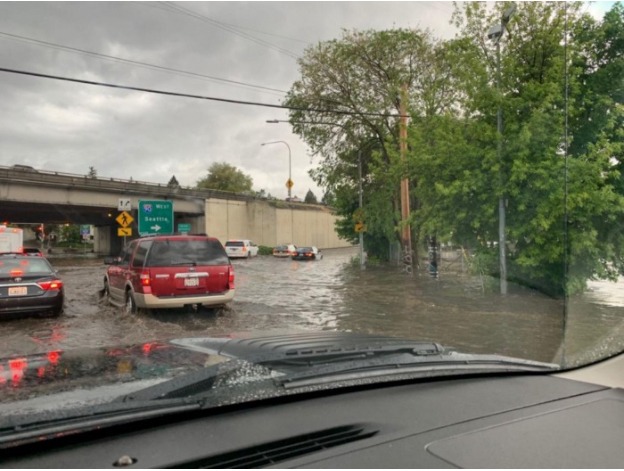Urban Flooding doesn't have to be the New Normal
Severe weather in the U.S. takes a hefty economic and societal toll each year. In 2019 alone, at the time of this writing, there have been 10 weather events that each resulted in losses greater than $1 Billion. Of these, 3 included severe floods and 5 included “severe storm events”.

When I think of flooding, extreme images of Houston, New Orleans, and Tohoku readily come to mind. But urban flooding in U.S. cities happens far more commonly than the mainstream news storm event, and they cumulatively take a bigger economic toll.
More recent scenes like these in New York or Spokane don’t get national attention because they’re local and not quite “natural disasters”. But flooding events like these happen more often than you’d think and they go mostly unnoticed…save for the local residents that end up dealing with the damage.
A changing climate is making these events more frequent, but it doesn’t help that our cities are caked in impervious concrete and asphalt. Up to 40 percent of U.S. cities are covered by impervious surfaces in the form of roads, parking lots, sidewalks, and other pavements. Rain and melted snow that would naturally soak back into the earth and feed a normal hydrologic cycle instead turns into high volume stormwater runoff. That polluted runoff is channeled to wherever the grade was designed to take it, usually far away from where it originally fell.
Under normal conditions, stormwater runoff goes to a treatment plant to be cleaned before it’s discharged into our water systems. But more, a city’s downstream infrastructure gets completely overwhelmed by the sheer volume of runoff. The result is polluted discharge spewing into our rivers or up through manholes and into the street.
Better Stormwater Management
Stormwater management is the policy, planning, engineering, implementation, and maintenance of urban water systems and it is critical for the sustainability of clean water in cities. The classic approach to stormwater management entails channeling water away from impervious surfaces and the structures built atop them. We’ve constructed our cities on the assumption that the water that would have been absorbed back into the land can be transported away instead.
The problem is that the policies and the engineering that support an urban stormwater management plan is conceived within the expectations of past norms. But with weather events becoming much more unpredictable and urbanization adding thousands of miles of impervious surface area to our cities every year, designing stormwater systems with data from even five years ago is infeasible and dangerous.
Unpaving the Way?
Many urban planners point to impervious surfaces as the problem. Cities like Baltimore have even begun removing thousands of acres of pavement.
But pavement reduction as the sole cure for urban flooding isn’t scalable. Urban development continues to increase and pavements (roads, sidewalks, etc.) play a critical role in the transportation of people and goods, amongst other things.
Mimicking rural hydrology with green space is smart, but it is also limited by scale. Usable space in dense urban areas comes at a premium because there simply isn’t much of it. It’s why some cities questionably allow developers to build on flood plains and many other cities struggle with urban sprawl. There simply isn’t an endless supply of land area for stormwater parks, rain gardens, and vegetated swales. And where there is available space, it’s undoubtedly expensive. No question green infrastructure has a role to play in stormwater management, along with improving grey infrastructure. But to solve this issue at any meaningful scale, we need a whole new toolkit altogether.
The Future of Hardscape Infrastructure
If urban flooding can be tied to cities having too much impervious surface area and not enough green space, we can determine the huge role that permeable pavement will have in the future of urban infrastructure. Permeable pavement theoretically provides the function of normal pavement, while also playing the role of “green space” by allowing water to soak through it and into the ground below. But current market technologies are limited by their material capabilities.
Nevertheless, innovation is relentless. And it is usually driven by need. $103 Billion need Today there are cement and material technology startups developing the material of the future for on-site stormwater management. By creating permeable hardscape material that is extremely strong, with the ability to filter out contaminants in stormwater, cities will have the ability to greatly mitigate urban flooding and “future proof” themselves in ways that are actually scalable and practical. The ability of hardscape material is evolving, and it holds the key to sustainable water infrastructure in our cities.
solutions for change
AquiPor just received 3rd party testing results on the absorption rate of our technology. Why is this important? According to ASTM C […]
Urban flooding, aging infrastructure, and polluted waterways are symptoms of a broken stormwater system—one that wasn’t built for the climate challenges cities […]
When LA turned it’s river into a storm drain Starting in the 1930’s Los Angeles turned the LA river into a big […]
Copyright © 2025 AquiPor Technologies. Site designed & developed by Houdini Interactive.